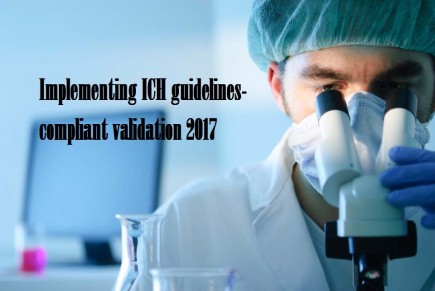Implementing ICH guidelines-compliant validation

Professionals in the field of statistical analysis need to possess clarity on understanding and interpreting statistical concepts used to investigate quantitative ICH Guidelines, such as:
- Analytical methods validation
- Procedures and acceptance criteria in calibration limits
- Process and Quality Control
- Process and quality controls
- ICH Q8 and Q9.
ICH tripartite-harmonized ICH Guideline on Methodology, which used to be previously coded as Q2B is the ICH guideline for procedures and acceptance criteria in calibration limits. Finalized in November 1996 under Step 4; this guideline extends the ICH guideline on Text, or what is called Q2A (mentioned above). It comprises the actual experimental data required, along with the statistical interpretation, for the validation of a variety of analytical procedures.
Current Step 4 for process and Quality Control

The Current Step 4 version of the ICH-harmonized Tripartite Guideline is the current guideline for process and Quality Control. The regulatory bodies of the three biggest pharmaceutical markets in the world, namely the US, the EU and Japan have recommended the final draft of this guideline for adoption.
Professionals who want to achieve harmonization in Quality Meeting are required to meet critical milestones. These milestones include conducting stability studies, understanding the way the studies define relevant limits for the testing of impurities, and following a more flexible approach to pharmaceutical quality that is based on the principles of Good Manufacturing Practice (GMP) risk management. The ICH’s Quality guidelines on harmonization relating to Quality cover the following areas:
- Stability
- Analytical Validation
- Impurities
- Pharmacopoeias
- Quality of Biotechnological Products
- Specifications
- Good Manufacturing Practice
- Pharmaceutical Development
- Quality Risk Management
- Pharmaceutical Quality System
- Development and Manufacture of Drug Substances
- Lifecycle Management.

Considering the complexity and the breadth of the issues associated with these techniques, which cover both the pharmaceutical and clinical applications, and considering that these techniques apply to a number of area such as stability testing, outlier analysis and risk management; it is important and necessary for professionals in this area to get proper guidance on validation.
GlobalCompliancePanel, a leading provider of professional trainings for the areas of regulatory compliance, will offer this learning at a seminar that it is organizing. The Director of this seminar is Dr. Alfred Bartolucci, who serves as Emeritus Professor of Biostatistics at the University of Alabama. To register for this seminar, please visit Implementing ICH guidelines-compliant validation. This seminar has been pre-approved by RAPS as eligible for up to 12 credits towards a participant’s RAC recertification upon full completion.
A thorough understanding of statistical concepts

The statistical concepts used for investigating quantitative ICH Guidelines, such as analytical methods validation, procedures and acceptance criteria in calibration limits, and process and Quality Control, as well as with ICH Q8 and Q9, will all be covered in depth at this seminar.
Although not a formal course in statistics, this seminar will offer an applied approach to the statistical techniques used and will show how to reasonably interpret them. This learning will help participants to address the various challenges facing pharmaceutical and biotechnology companies when they are required to quantify results in a meaningful interpretable manner through tabulations and graphical presentations.
The expectations of different regulatory agencies regarding the quantification and development of a sound statistical monitoring of a properly utilized, effective, and efficient process control will also be taken up for discussion at this seminar. Dr. Bartolucci will familiarize the participants with the critical aspects of the statistical methods. He will explain the practical application of these guidelines.
This seminar will offer the following learning objectives:
- Evaluate linear quantitative measurement procedures and sources of error
- Distinguish the difference between confidence and tolerance intervals
- Evaluate the appropriateness of the effect of sample size in given procedures
- Evaluate laboratory/clinical quality control based on risk management
- Interpret statistical process control
- Distinguish between FDA requirements and ICH guidelines.
Labels: fda guidelines statistical analysis plan, guidelines statistical analysis, ich guidelines statistical principles clinical trials, student statistical collection guidelines

0 Comments:
Post a Comment
Subscribe to Post Comments [Atom]
<< Home